 |
 |
|
 |
 |
the last stage of mid sized stars
Visit also our mobile website
Planetary nebula are extremly small objects.
They occur at the end of the life cycle of medium sized stars like our Sun. First they grow to red giant stars expelling ionized gas and shedding their outer shell in the surrounding interstellar
medium before contracting to white dwarf stars. This expelled gas forms the planetary nebula
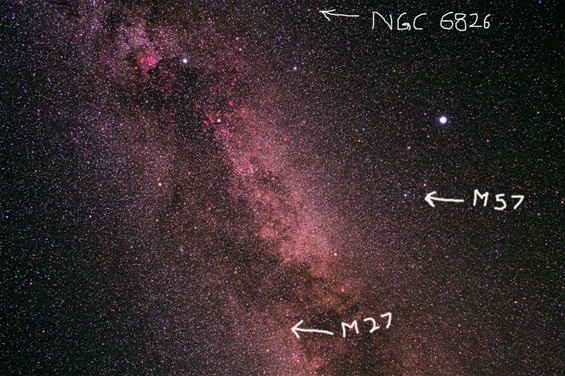 Constellations Cygnus, Vulpecula and Lyra in the Orion-Cygnus arm of our Milky Way with the position of the extremely small planetary nebulae M27(Dumbbell nebula), M57(Ring Nebula) and NGC 6826(blinking planetary nebula).
Constellations Cygnus, Vulpecula and Lyra in the Orion-Cygnus arm of our Milky Way with the position of the extremely small planetary nebulae M27(Dumbbell nebula), M57(Ring Nebula) and NGC 6826(blinking planetary nebula).
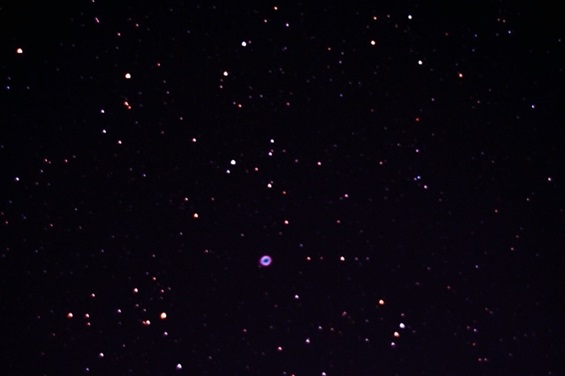 Ring Nebula M57 in Lyra. Description see below.
This Astro photo taken using the Celestron Comet Catcher 500mm focal lenght, f: 3,6 unguided on Astrotrac mount close to Vienna, Austria. Magnified detail, not so bad for an unguided exposure using a 5,5inch Schmidt Newtonian delivering only 75% coma correction as compared to the photo above taken with the larger 8inch Newtonian and full coma corrector!
Ring Nebula M57 in Lyra. Description see below.
This Astro photo taken using the Celestron Comet Catcher 500mm focal lenght, f: 3,6 unguided on Astrotrac mount close to Vienna, Austria. Magnified detail, not so bad for an unguided exposure using a 5,5inch Schmidt Newtonian delivering only 75% coma correction as compared to the photo above taken with the larger 8inch Newtonian and full coma corrector!
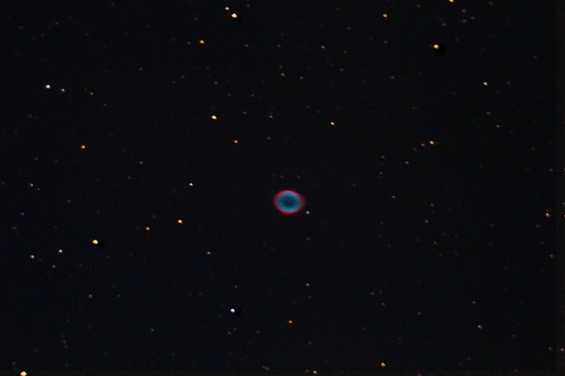 Ring Nebula M57 in Lyra. Description see below.
This Astro photo taken using Meade 10 inch SC, 2500mm focal lenght, f: 10 close to Vienna, Austria.
Ring Nebula M57 in Lyra. Description see below.
This Astro photo taken using Meade 10 inch SC, 2500mm focal lenght, f: 10 close to Vienna, Austria.
 Ring Nebula M 57 in Lyra Astro photo taken with a Celestron C 14 30km east of Vienna, Austria
Aren't the colors amazing. That's the end of a mid size star like our Sun when they contract to white dwarf stars and shed their outer layers to form a planetary nebula.
2300lightyears away, about 0,9 lightyears diameter
Astrophoto C14
Ring Nebula M 57 in Lyra Astro photo taken with a Celestron C 14 30km east of Vienna, Austria
Aren't the colors amazing. That's the end of a mid size star like our Sun when they contract to white dwarf stars and shed their outer layers to form a planetary nebula.
2300lightyears away, about 0,9 lightyears diameter
Astrophoto C14
 M57 the Ring Nebula taken with Celestron C14 and Orion Starshoot Pro CCD color Camera
8 exposures 60sec each
M57 the Ring Nebula taken with Celestron C14 and Orion Starshoot Pro CCD color Camera
8 exposures 60sec each
 M57 stack of the astro photos above taken with Orion Starshoot pro and EOS 40d
M57 stack of the astro photos above taken with Orion Starshoot pro and EOS 40d
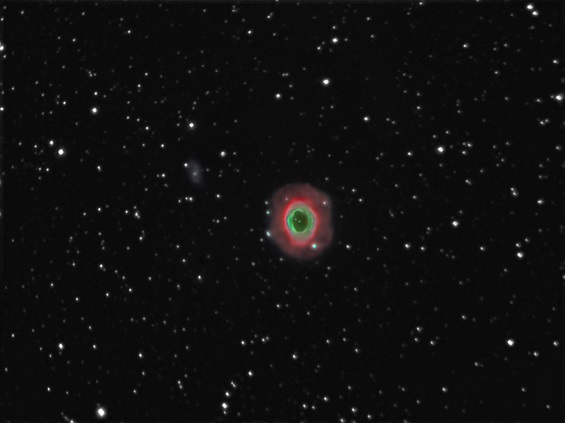 Ring Nebula M 57 in Lyra with Halo
Distance 2300 lightyears,diameter 0,9 LY, with halo 2,5LY
Astrophoto taken with Celestron C14 and focal reducer at F=2500mm f7
SBIG 2000 XM monochrome CCD Camera, stack of:
Luminance: 3x600 sec 1x1 and 3x600sec 2x2 halpha
R: 3x200sec 2x2 and 3x600sec Halpha
G: 3x200sec 2x2 binning
B: 3x200sec 2x2
Ring Nebula M 57 in Lyra with Halo
Distance 2300 lightyears,diameter 0,9 LY, with halo 2,5LY
Astrophoto taken with Celestron C14 and focal reducer at F=2500mm f7
SBIG 2000 XM monochrome CCD Camera, stack of:
Luminance: 3x600 sec 1x1 and 3x600sec 2x2 halpha
R: 3x200sec 2x2 and 3x600sec Halpha
G: 3x200sec 2x2 binning
B: 3x200sec 2x2
 NGC 6826 the blinking planetary nebula in Cygnus.
The planetary nebula is 4200LY away and has a diameter of 0,6LY, so same size but nearly three times farer away than the Ring Nebula.
Astro photo taken with Celestron C14, stack of 20 exposures of 300 sec at 100,200,400,800 and 3200 ISO and 3 exp 420 sec at 800 ISO with UHC filter.
Astrophoto C 14
NGC 6826 the blinking planetary nebula in Cygnus.
The planetary nebula is 4200LY away and has a diameter of 0,6LY, so same size but nearly three times farer away than the Ring Nebula.
Astro photo taken with Celestron C14, stack of 20 exposures of 300 sec at 100,200,400,800 and 3200 ISO and 3 exp 420 sec at 800 ISO with UHC filter.
Astrophoto C 14
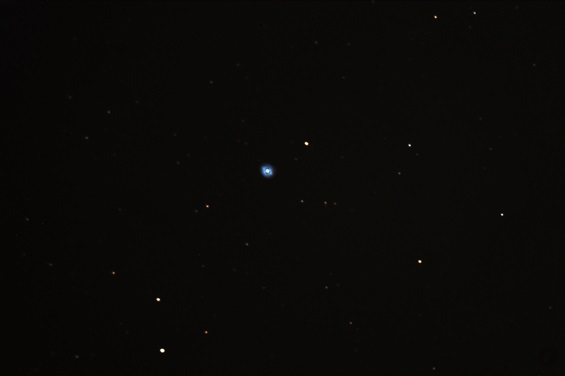 NGC 6826 the blinking planetary nebula in Cygnus.
The planetary nebula is 4200LY away and has a diameter of 0,6LY, so same size but nearly three times farer away than the Ring Nebula.
Astro photo taken with Celestron C14, stack of 8 exposures with Orion Starshoot Pro Color CCD camera:
2x2binning: 2x80sec, 2x200sec
1x1color: 4x200sec
Astrophoto C 14
NGC 6826 the blinking planetary nebula in Cygnus.
The planetary nebula is 4200LY away and has a diameter of 0,6LY, so same size but nearly three times farer away than the Ring Nebula.
Astro photo taken with Celestron C14, stack of 8 exposures with Orion Starshoot Pro Color CCD camera:
2x2binning: 2x80sec, 2x200sec
1x1color: 4x200sec
Astrophoto C 14
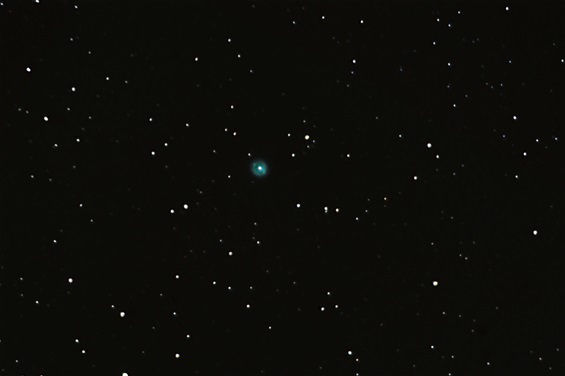 Blinking Planetary Nebula, Astro Photo taken with Celestron C 14:
Luminance EOS 450d Monochrome 2x600sec ISO 1600, 3x300sec ISO 400, 3x120sec ISO 400, 3x60sec ISO 400
RGB: Orion Starshoot Pro V2 color CCD camera: 3x600sec, 3x200sec,3x100sec
Blinking Planetary Nebula, Astro Photo taken with Celestron C 14:
Luminance EOS 450d Monochrome 2x600sec ISO 1600, 3x300sec ISO 400, 3x120sec ISO 400, 3x60sec ISO 400
RGB: Orion Starshoot Pro V2 color CCD camera: 3x600sec, 3x200sec,3x100sec
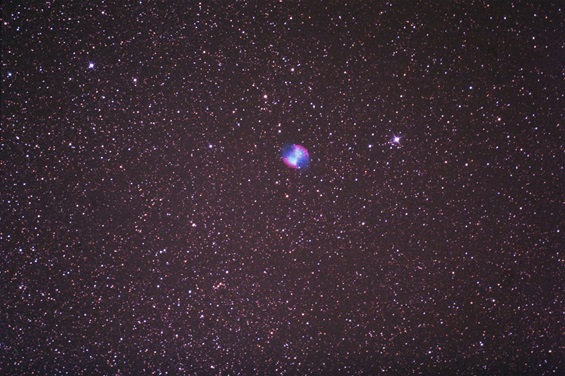 Dumbbell Nebula M 27 in Vulpecula, next to Cygnus
Astro photo taken with Skywatcher Newton 0,6m focal length and 13cm aperture on EQ3 mount guided by MGEN on the south coast of Crete Greece
This was the first planetary nebula observed, it's way bigger than M57, the ring nebula
Dumbbell Nebula M 27 in Vulpecula, next to Cygnus
Astro photo taken with Skywatcher Newton 0,6m focal length and 13cm aperture on EQ3 mount guided by MGEN on the south coast of Crete Greece
This was the first planetary nebula observed, it's way bigger than M57, the ring nebula
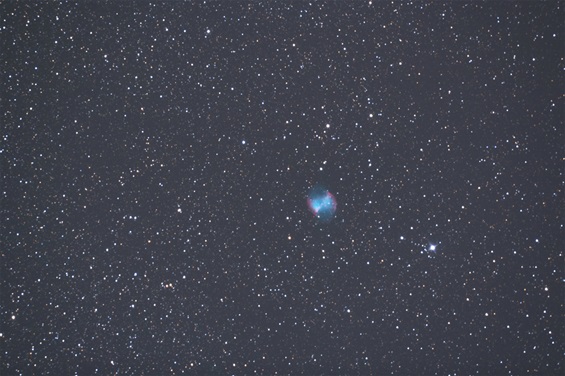 Dumbbbell Nebula, Planetary Nebula M27 taken with Newton 6 inch f4 on EQ 3 mount and Canon EOS 550d modified, 5 exp a 190 sec ISO 1600
Dumbbbell Nebula, Planetary Nebula M27 taken with Newton 6 inch f4 on EQ 3 mount and Canon EOS 550d modified, 5 exp a 190 sec ISO 1600
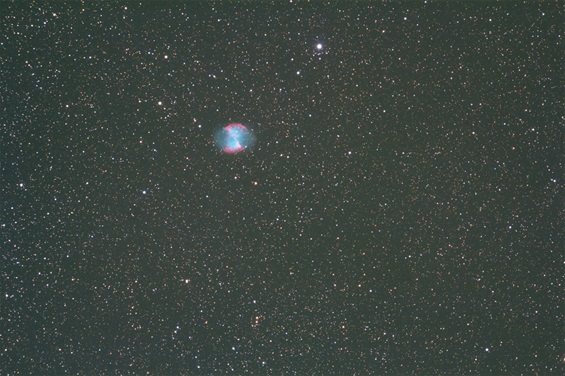 PN M27 Dumbbell Nebula taken with APM APO 170 700mm and EOS 550d modified ISO 800 4 exp 5-8 min each
PN M27 Dumbbell Nebula taken with APM APO 170 700mm and EOS 550d modified ISO 800 4 exp 5-8 min each
 M 27 Dumbbell Nebula taken with Explore scientific 80/480 Triplet APO, 2 exposures 200 ISO, 6min each Canon 600d modified; magnified detail
M 27 Dumbbell Nebula taken with Explore scientific 80/480 Triplet APO, 2 exposures 200 ISO, 6min each Canon 600d modified; magnified detail
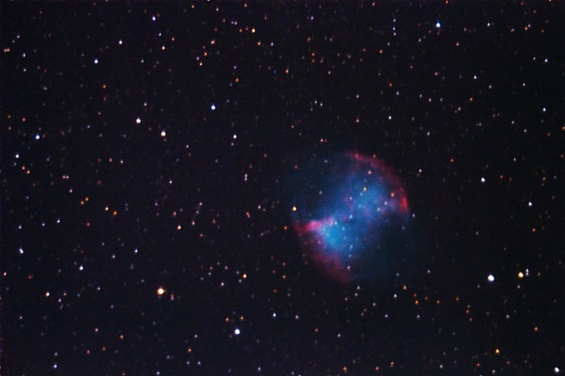 Dumbbell nebula M 27, astro photo taken with 10inch Meade SC near Vienna, Austria.
Dumbbell nebula M 27, astro photo taken with 10inch Meade SC near Vienna, Austria.
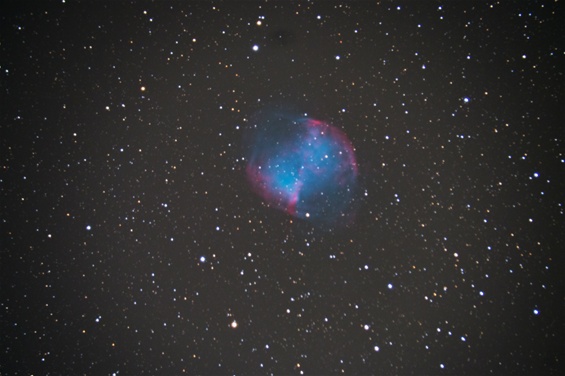 Dumbbell Nebula M27 taken with Celestron C14 and focal reducer at f6,3.
Dumbbell Nebula M27 taken with Celestron C14 and focal reducer at f6,3.
 Dumbbell nebula M 27 in Vulpecula.
Astro photo taken with a Celestron C 14 30km east of Vienna, Austria.
Same magnification as the pic below of the smaller brother, the little dumbbell nebula, but later stage of development. Only 1000 lightyears away and about 2,4 lightyepars diameter
Astrophoto C14
Dumbbell nebula M 27 in Vulpecula.
Astro photo taken with a Celestron C 14 30km east of Vienna, Austria.
Same magnification as the pic below of the smaller brother, the little dumbbell nebula, but later stage of development. Only 1000 lightyears away and about 2,4 lightyepars diameter
Astrophoto C14
 Dumbbell Nebula M27 taken with Celestron C14 and focal reducer at F 2500mm f7
Canon Eos 450d mono
Luminance: 4x460sec CLS and 2x880sec UHC 1600ISO each
OIII 2x880sec 1600ISO
Dumbbell Nebula M27 taken with Celestron C14 and focal reducer at F 2500mm f7
Canon Eos 450d mono
Luminance: 4x460sec CLS and 2x880sec UHC 1600ISO each
OIII 2x880sec 1600ISO
 Dumbbell Nebula M 27 composite of the four astrophotos above taken with Celestgron C 14 at full focal lenght, with focal reducer and with Meade 10inch SC at full focal lenght.
Dumbbell Nebula M 27 composite of the four astrophotos above taken with Celestgron C 14 at full focal lenght, with focal reducer and with Meade 10inch SC at full focal lenght.
 Little Dumbbell Nebula M 76, 2000 lightyears away about 1,3 lightyears diameter, double the distance and 50% smaller than its big brother the Dumbbell nebula.
A small planetary nebula in constellation Perseus, it covers only the apparent size of less than 7% of the full Moon.
Astro photo taken with Celestron C 14, 35,6cm Aperture composite of 5 exp with 4m focal length, 400sec, 1600ISO (2exp without filter,2exp with OIII filter and 1exp with Halpha) , and 4 exp with focal reducer, F='2,5m, 400sec, 800ISO (3exp with UHC filter and 1exp with Halpha filter)
Astrophoto C14
Little Dumbbell Nebula M 76, 2000 lightyears away about 1,3 lightyears diameter, double the distance and 50% smaller than its big brother the Dumbbell nebula.
A small planetary nebula in constellation Perseus, it covers only the apparent size of less than 7% of the full Moon.
Astro photo taken with Celestron C 14, 35,6cm Aperture composite of 5 exp with 4m focal length, 400sec, 1600ISO (2exp without filter,2exp with OIII filter and 1exp with Halpha) , and 4 exp with focal reducer, F='2,5m, 400sec, 800ISO (3exp with UHC filter and 1exp with Halpha filter)
Astrophoto C14
 Little Dumbbell Nebula M76
Astro photo taken with Celestron C14 at F 3910mm close to Vienna
Luminance: Canon EOS 450 d monoichrome 3x600sec and 1x 900 sec
RGB: Orion Starshoot Pro Color CCD Camera 8x600 sec
Astrphoto C14
Little Dumbbell Nebula M76
Astro photo taken with Celestron C14 at F 3910mm close to Vienna
Luminance: Canon EOS 450 d monoichrome 3x600sec and 1x 900 sec
RGB: Orion Starshoot Pro Color CCD Camera 8x600 sec
Astrphoto C14
 Little Dumbell Nebula Astro photo taken with Skywatcher Photonewton 8 inch and Atik Infinity 200x5sec
Little Dumbell Nebula Astro photo taken with Skywatcher Photonewton 8 inch and Atik Infinity 200x5sec
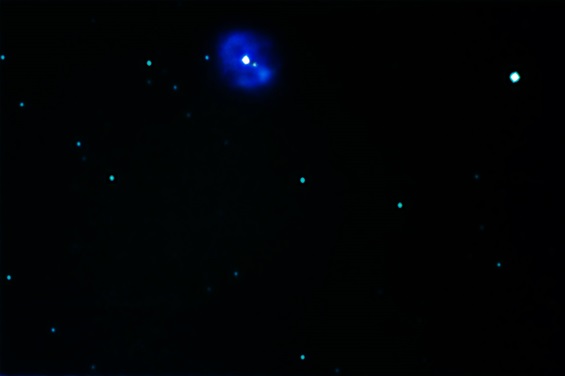 Crystal Ball nebula NGC 1514 in Taurus, distance only 600 lightyears.
The central star is very bright in case of this planetary nebula which is an exception.
Astro photo taken with a Celestron C 14 and Canon EOS 40d mod. 30km east of Vienna, Austria.
Astrophoto C14
Crystal Ball nebula NGC 1514 in Taurus, distance only 600 lightyears.
The central star is very bright in case of this planetary nebula which is an exception.
Astro photo taken with a Celestron C 14 and Canon EOS 40d mod. 30km east of Vienna, Austria.
Astrophoto C14
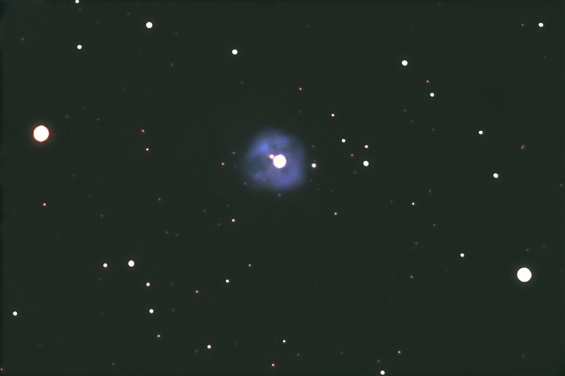 Crystal Ball nebula NGC 1514 in Taurus, distance only 600 lightyears. Apparent size 2,2 arcmin
The central star is very bright in case of this planetary nebula which is an exception.
Astro photo taken with Celestron C14 and Orion Starshoot Pro CCD Camera:
4x800sec + 1x1000sec
Crystal Ball nebula NGC 1514 in Taurus, distance only 600 lightyears. Apparent size 2,2 arcmin
The central star is very bright in case of this planetary nebula which is an exception.
Astro photo taken with Celestron C14 and Orion Starshoot Pro CCD Camera:
4x800sec + 1x1000sec
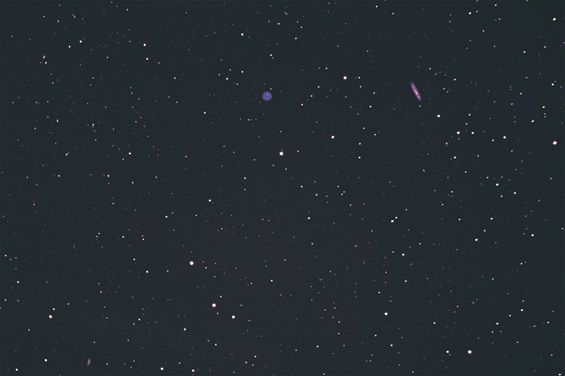 Planetary Nebula M97 and Galaxy M109, on the bottom left you can see also galaxy NGC 3549.
Astro photo taken with 80/480 triplet APO and 0,79 reducer
6 exp a 80 sec ISO 1600 with Canon EOS 450d mono and 10 exp a 80 sec 1600 ISO wih Canon EOS 40d modified
Planetary Nebula M97 and Galaxy M109, on the bottom left you can see also galaxy NGC 3549.
Astro photo taken with 80/480 triplet APO and 0,79 reducer
6 exp a 80 sec ISO 1600 with Canon EOS 450d mono and 10 exp a 80 sec 1600 ISO wih Canon EOS 40d modified
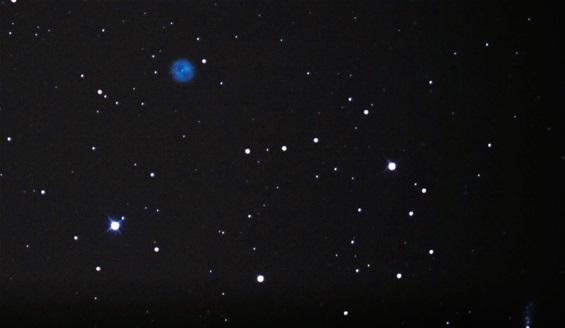 Owl nebula M 97, a planetary nebula in Ursa Maior with a diameter of 2.2 lightyears about four times the size of the Ring nebula and 2200 lightyears away. Also on the pic part of the galaxy M 108
Astro photo taken with 8 inch newton telescope with coma corrector reducer and Canon EOS 1000d non modified, 73cm effective focal length and canon 30 km off Vienna , Austria
Owl nebula M 97, a planetary nebula in Ursa Maior with a diameter of 2.2 lightyears about four times the size of the Ring nebula and 2200 lightyears away. Also on the pic part of the galaxy M 108
Astro photo taken with 8 inch newton telescope with coma corrector reducer and Canon EOS 1000d non modified, 73cm effective focal length and canon 30 km off Vienna , Austria
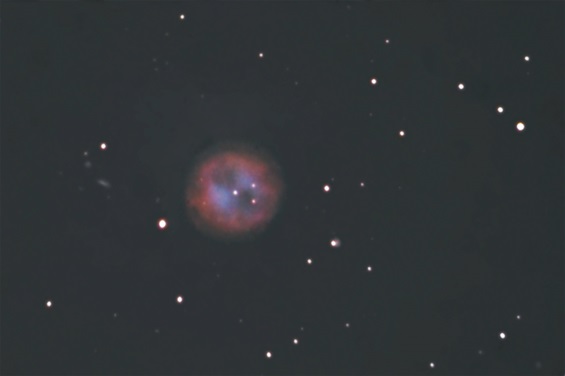 Owl nebula M 97, close up with Celestron C 14. Stack of exposures with ORION Starshoot Pro CCD camera
2x2binning Mono: 2x400sec, 4x600sec
1x1binning Color:2x400sec, 2x600sec
Astrophoto C14
Owl nebula M 97, close up with Celestron C 14. Stack of exposures with ORION Starshoot Pro CCD camera
2x2binning Mono: 2x400sec, 4x600sec
1x1binning Color:2x400sec, 2x600sec
Astrophoto C14
 The Owl Nebula M 97and a number of remote galaxies between 900 and 1000 Mio LY away!!
stack of 9 exposures with Celestron C14 and focal reducer at f7, F=2500mm and Canon EOS 450d monochrome:
luminance 3*7min 1600ISO CLS filter
R 3*12min 1600ISO Halpha
B and G 3*12min 1600ISO OIII
Astrophoto C14
The Owl Nebula M 97and a number of remote galaxies between 900 and 1000 Mio LY away!!
stack of 9 exposures with Celestron C14 and focal reducer at f7, F=2500mm and Canon EOS 450d monochrome:
luminance 3*7min 1600ISO CLS filter
R 3*12min 1600ISO Halpha
B and G 3*12min 1600ISO OIII
Astrophoto C14
 Owl nebula M97 composite of the 2 astro photos above
Owl nebula M97 composite of the 2 astro photos above
 NGC 6781 in the constellation Aquila.
This planetary nebula is 3000LY away and has a diameter of about 1,7LY, so its about three times the size of the Ring Nebula but twice as far away.
Asto photo composite of:
1.Stack of 12 exposures of 9 minutes at 1600 ISO using a UHC filter one day before full moon taken with Celestron C 14 and Canon EOS 600d modified close to Vienna, Austria. Astrophoto C14.
2.3 exposures with Canon 600d ISO 800, 560sec each and 3 exp at 1600ISO 180sec each taken at Emberger Alm Carinthia, Austria during the 30th International Telescope Meeting ITT Internationales Teleskoptreffen with a Meade 10inch SC anf focal reducer at f6,3.
NGC 6781 in the constellation Aquila.
This planetary nebula is 3000LY away and has a diameter of about 1,7LY, so its about three times the size of the Ring Nebula but twice as far away.
Asto photo composite of:
1.Stack of 12 exposures of 9 minutes at 1600 ISO using a UHC filter one day before full moon taken with Celestron C 14 and Canon EOS 600d modified close to Vienna, Austria. Astrophoto C14.
2.3 exposures with Canon 600d ISO 800, 560sec each and 3 exp at 1600ISO 180sec each taken at Emberger Alm Carinthia, Austria during the 30th International Telescope Meeting ITT Internationales Teleskoptreffen with a Meade 10inch SC anf focal reducer at f6,3.
 NGC 7048, a planetary nebula in Cygnus,diameter 1,8LY, distance 6000LY, i.e. 3times the size of the Ring Nebula, but four times farer away.
Astro photo taken with Celestron C14 and focal reducer at F=2500mm, f 6,3 using Canon 600d.
Stack of 6 exp: 2x200sec 3200 ISO UHC, 2x 800sec 800 ISO UHC, 2x 500 sec CLS filter.
astrophoto C141
NGC 7048, a planetary nebula in Cygnus,diameter 1,8LY, distance 6000LY, i.e. 3times the size of the Ring Nebula, but four times farer away.
Astro photo taken with Celestron C14 and focal reducer at F=2500mm, f 6,3 using Canon 600d.
Stack of 6 exp: 2x200sec 3200 ISO UHC, 2x 800sec 800 ISO UHC, 2x 500 sec CLS filter.
astrophoto C141
 Helix Nebula NGC 7293 in Aquarius, called The Eye of God. It really looks like an eye looking from heaven down to us. Its a planetary nebula similar to the Ring Nebula in Lyra only 12 times larger in perceived diameter
(compare pic taken of Ring Nebula with C 14 at 20 times longer focal length above) The reasons are, that the Helix nebula is only 600 light years away compared to the 1500 light years of the Ring Nebula, and with a diameter of 3 lightyears it's 5 times larger.
Astro photo taken using a Canon 200mm L lens at Nicoya peninsula, Costa Rica
Helix Nebula NGC 7293 in Aquarius, called The Eye of God. It really looks like an eye looking from heaven down to us. Its a planetary nebula similar to the Ring Nebula in Lyra only 12 times larger in perceived diameter
(compare pic taken of Ring Nebula with C 14 at 20 times longer focal length above) The reasons are, that the Helix nebula is only 600 light years away compared to the 1500 light years of the Ring Nebula, and with a diameter of 3 lightyears it's 5 times larger.
Astro photo taken using a Canon 200mm L lens at Nicoya peninsula, Costa Rica
 Helix Nebula
Astro photo taken with Skywatcher Newton 0,6m focal length and 13cm aperture on EQ3 mount guided by MGEN on the south coast of Crete Greece
Unfortunately windy conditions this night
Helix Nebula
Astro photo taken with Skywatcher Newton 0,6m focal length and 13cm aperture on EQ3 mount guided by MGEN on the south coast of Crete Greece
Unfortunately windy conditions this night
 Helix Nebula taken at Emberger Alm Carinthia, Austria during the 30th International Telescope Meeting ITT Internationales Teleskoptreffen with a Meade 10inch SC anf focal reducer at f6,3.
4 exposures with Canon 600d ISO 800, 850sec each.
Helix Nebula was close to horizon so I made a composite with the Newton astro photo at Crete above to brighten the colors a little.
Helix Nebula taken at Emberger Alm Carinthia, Austria during the 30th International Telescope Meeting ITT Internationales Teleskoptreffen with a Meade 10inch SC anf focal reducer at f6,3.
4 exposures with Canon 600d ISO 800, 850sec each.
Helix Nebula was close to horizon so I made a composite with the Newton astro photo at Crete above to brighten the colors a little.
 Cats Eye Nebula NGC 6543 is a planetary nebula in Draco, diameter 0,4 lightyears, distance 3500 lightyears.
Even taken with a Celestron C 14 at 4m focal lenght this planetary is so tiny! Its twice the distance and only 2/3 the size of the ring nebula in Lyra. 12 exposures between 10 and 250sec, Orion Starshoot Pro Color CCD Camera.
On the right top you see a crop of the planetary nebula
Astrophoto C14
Cats Eye Nebula NGC 6543 is a planetary nebula in Draco, diameter 0,4 lightyears, distance 3500 lightyears.
Even taken with a Celestron C 14 at 4m focal lenght this planetary is so tiny! Its twice the distance and only 2/3 the size of the ring nebula in Lyra. 12 exposures between 10 and 250sec, Orion Starshoot Pro Color CCD Camera.
On the right top you see a crop of the planetary nebula
Astrophoto C14
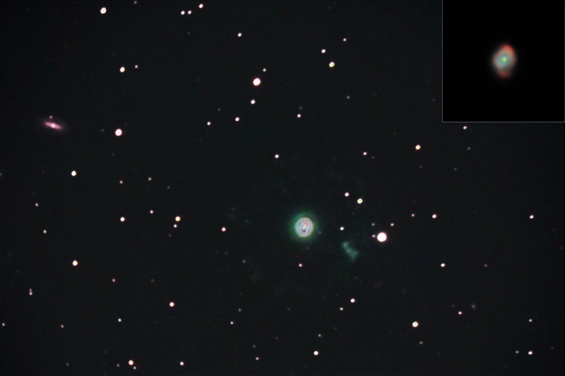 Cats Eye Nebula NGC 6543 is a planetary nebula in Draco, diameter 0,4 lightyears, distance 3500 lightyears.
Even taken with a Celestron C 14 at 4m focal lenght this planetary is so tiny! Its twice the distance and only 2/3 the size of the ring nebula in Lyra. 12 exposures between 10 and 250sec, Orion Starshoot Pro Color CCD Camera. And with focal reducer at F2500mm EOS 450d mono LumISO 1600 3exp15min eachand 3exp 10min each using cls, RGB EOS 40d 2y7min ISO 3200 CLS, 2x6min ISO 3200 CLS. You can see the halo of th PN and on the left top the gx NGC 6552, 350mio LY distance.
On the right top you see a crop of the planetary nebula
Astrophoto C14
Cats Eye Nebula NGC 6543 is a planetary nebula in Draco, diameter 0,4 lightyears, distance 3500 lightyears.
Even taken with a Celestron C 14 at 4m focal lenght this planetary is so tiny! Its twice the distance and only 2/3 the size of the ring nebula in Lyra. 12 exposures between 10 and 250sec, Orion Starshoot Pro Color CCD Camera. And with focal reducer at F2500mm EOS 450d mono LumISO 1600 3exp15min eachand 3exp 10min each using cls, RGB EOS 40d 2y7min ISO 3200 CLS, 2x6min ISO 3200 CLS. You can see the halo of th PN and on the left top the gx NGC 6552, 350mio LY distance.
On the right top you see a crop of the planetary nebula
Astrophoto C14
 Fetus Nebula NGC 7008 in constellation Cygnus, a planetary nebula 2800LY away, diameter 1,4LY.
Astro photo taken with Celestron C14 and focal reducer at f7; stack of 4 exp using CLS filter, 500 sec each.
Astrophoto C14
Fetus Nebula NGC 7008 in constellation Cygnus, a planetary nebula 2800LY away, diameter 1,4LY.
Astro photo taken with Celestron C14 and focal reducer at f7; stack of 4 exp using CLS filter, 500 sec each.
Astrophoto C14
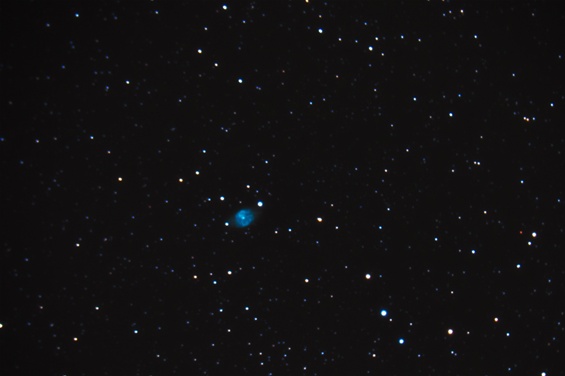 Blue Flash Nebula NGC 6905 in Delphinus, distance 4700LY taken with Celestron C14 using f6,3 focal reducer close to Vienna,Austria. Stack of 12 exposures with Canon Eos 600d:
3x270 sec 200ISO
3x270 sec 400ISO
3x270 sec 800ISO
3x520 sec 800ISO with UHC filter.
Astrophoto C14.
Blue Flash Nebula NGC 6905 in Delphinus, distance 4700LY taken with Celestron C14 using f6,3 focal reducer close to Vienna,Austria. Stack of 12 exposures with Canon Eos 600d:
3x270 sec 200ISO
3x270 sec 400ISO
3x270 sec 800ISO
3x520 sec 800ISO with UHC filter.
Astrophoto C14.
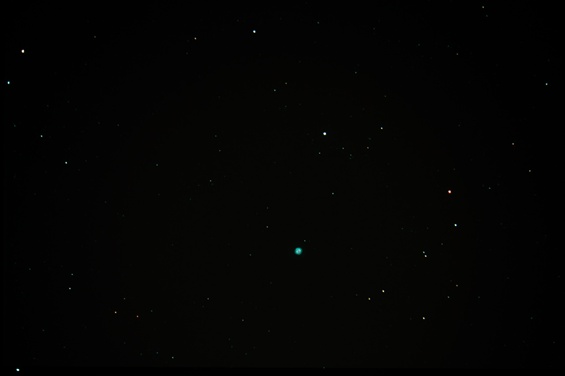 Blue Snowball Nebula, a planetary nebula in the constellation Andromeda, 5350LY away, diameter 0,8LY.
Astro photo taken with Celestron C14 and focal reducer at f7, F2500mm. Stack of 12 exposures: 3x 1600ISO 6min CLS, 3x 400ISO 6min CLS, 3x100ISO, 3min CLS, 3x 100ISO 3min without filter.
Astrophoto C14
Blue Snowball Nebula, a planetary nebula in the constellation Andromeda, 5350LY away, diameter 0,8LY.
Astro photo taken with Celestron C14 and focal reducer at f7, F2500mm. Stack of 12 exposures: 3x 1600ISO 6min CLS, 3x 400ISO 6min CLS, 3x100ISO, 3min CLS, 3x 100ISO 3min without filter.
Astrophoto C14
 Blue snowball crop of the astro photo above.
Blue snowball crop of the astro photo above.
 Eskimo Nebula in Taurus, 2870 lightyears away, diameter only 0,65 LY, so its relative size is only 47 arc sec in comparison to 3,4 arc min of Owl nebula.
Astrophoto C14
Eskimo Nebula in Taurus, 2870 lightyears away, diameter only 0,65 LY, so its relative size is only 47 arc sec in comparison to 3,4 arc min of Owl nebula.
Astrophoto C14
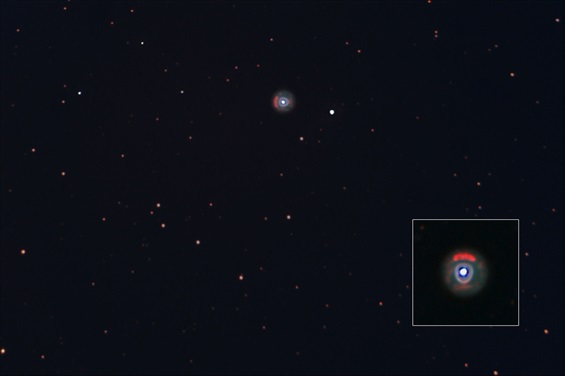 Eskimo Nebula in Gemini, distance 5000LY, diameter 0,7LY, th PN stems from a star reaching its final stage and blowing off its outer parts thus remaining as white dwarf star
Astro photo taken with celestron C14 and Orion star shoot pro V2 color Ccd camera
2x2binning mono: 3x200sec and 3x400sec
1x1binning color: 3x400sec and 3x 800 sec
Astrophoto c14
Eskimo Nebula in Gemini, distance 5000LY, diameter 0,7LY, th PN stems from a star reaching its final stage and blowing off its outer parts thus remaining as white dwarf star
Astro photo taken with celestron C14 and Orion star shoot pro V2 color Ccd camera
2x2binning mono: 3x200sec and 3x400sec
1x1binning color: 3x400sec and 3x 800 sec
Astrophoto c14
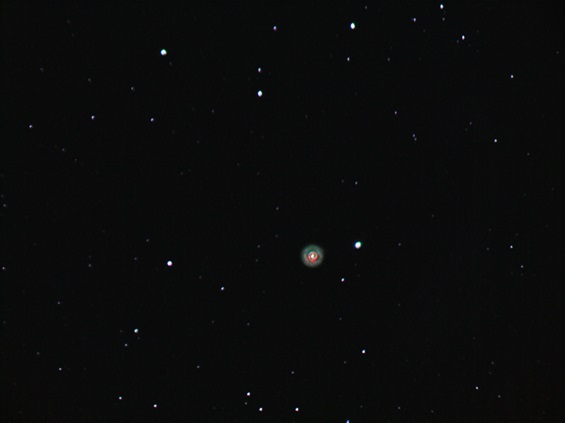 Eskimo Nebula in Gemini taken with Celestron C14 using a focal reducer at F=2500mm and SBIG 2000XM monochrome CCD Camera:
stack of:
luminance: 6x120sec,3x60sec,3x30sec,6x20sec
R:3x30sec
G:3x30sec
B:3x30sec
Eskimo Nebula in Taurus, 5000 lightyears away, diameter only 0,65 LY, so its relative size is only 47 arc sec in comparison to 3,4 arc min of Owl nebula.
Astrophoto C14
Eskimo Nebula in Gemini taken with Celestron C14 using a focal reducer at F=2500mm and SBIG 2000XM monochrome CCD Camera:
stack of:
luminance: 6x120sec,3x60sec,3x30sec,6x20sec
R:3x30sec
G:3x30sec
B:3x30sec
Eskimo Nebula in Taurus, 5000 lightyears away, diameter only 0,65 LY, so its relative size is only 47 arc sec in comparison to 3,4 arc min of Owl nebula.
Astrophoto C14
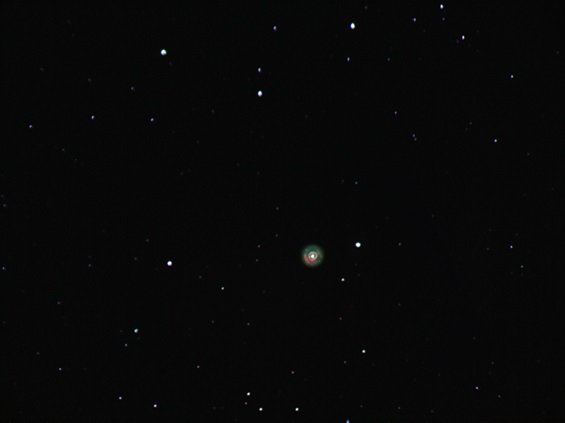 Eskimo Nebula in Gemini taken with Celestron C14
composite of :
1) using a focal reducer at F=2500mm and SBIG 2000XM monochrome CCD Camera:
stack of:
luminance: 6x120sec,3x60sec,3x30sec,6x20sec
R:3x30sec
G:3x30sec
B:3x30sec
2)Orion star shoot pro V2 color Ccd camera
2x2binning mono: 3x200sec and 3x400sec
1x1binning color: 3x400sec and 3x 800 sec
Eskimo Nebula in Taurus, 5000 lightyears away, diameter only 0,65 LY, so its relative size is only 47 arc sec in comparison to 3,4 arc min of Owl nebula.
Astrophoto C14
Eskimo Nebula in Gemini taken with Celestron C14
composite of :
1) using a focal reducer at F=2500mm and SBIG 2000XM monochrome CCD Camera:
stack of:
luminance: 6x120sec,3x60sec,3x30sec,6x20sec
R:3x30sec
G:3x30sec
B:3x30sec
2)Orion star shoot pro V2 color Ccd camera
2x2binning mono: 3x200sec and 3x400sec
1x1binning color: 3x400sec and 3x 800 sec
Eskimo Nebula in Taurus, 5000 lightyears away, diameter only 0,65 LY, so its relative size is only 47 arc sec in comparison to 3,4 arc min of Owl nebula.
Astrophoto C14
|
|
 |
|
|
|